|
- Catalog (in stock)
- Back-Catalog
- Mail Order
- Online Order
- Sounds
- Instruments
- Projects
- History Face
- ten years 87-97
- Review Face
- our friends
- Albis Face
- Albis - Photos
- Albis Work
- Links
- Home
- Contact
- Profil YouTube
- Overton Network
P & C December 1998
- Face Music / Albi
- last update 03-2016
|
1. Onowuliranga Mukwaano - wedding song - Buganda region - 4:27
2. Onkwatomugongo - wedding song - Ankole region - 3:59
3. Ngayaya - wedding song - Tooro region - 4:11
4. Naleyo - courtship dance - Karamoja region - 4:16
5. Agwera Foneni - welcome, happy to see you - Eastern region - 4:14
6. Abavubi - fishermen - Buganda region - 12:06
7. Yamulesire Omwana - wedding song - Bunyoro region - 8:59
8. Nkararayo - wedding song - Bunyoro region - 10:49
9. Owaro - welcome - gathering song - Eastern region - 7:12
10. Gaze - dance song from the Western Nile - 12:29
- With members from the Naggalabi Indigenous Theatre (NIT), a community of artists with a centre in Naggalabi for local, traditional and contemporary arts and crafts. The institution was founded by Sylvia Namulema Kigula and Eric Jjemba Lutaaya and is located in Nsangi su county Wakiso district, Uganda.
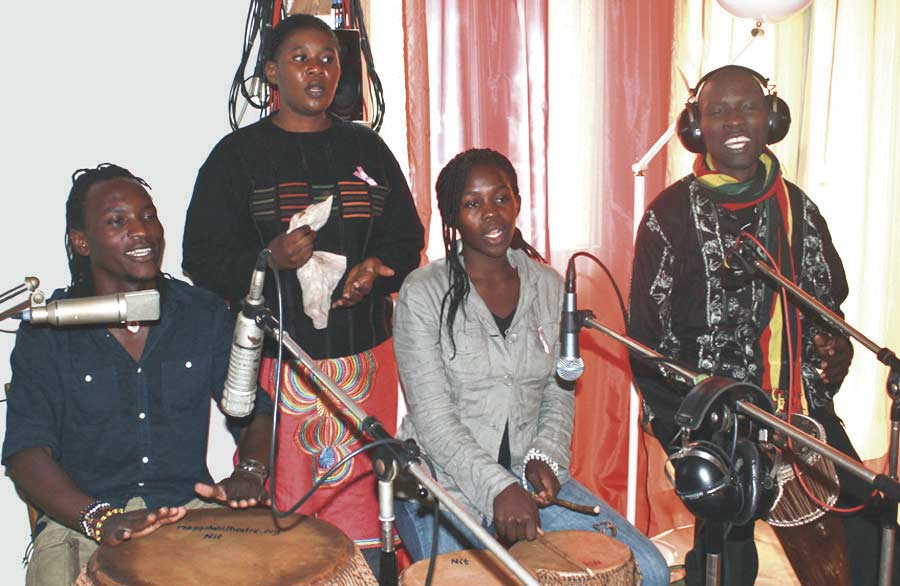
Israel, Sylvia, Ritah, Eric
Traditional music from Uganda
Africa is inhabited by different ethnic groups, each with a musical tradition of its own. This is a rich traditional music heritage that has been orally transmitted from generation to generation for centuries. Despite external influences, the majority of these ethnic groups continue to value and practise their respective traditional musical styles, which in turn have to establish strong musical and cultural identities and continue to do so.
Ugandan music is generally rhythmic and the complexity of these rhythms varies due to the difference between the ethnic groups. These differences are also reflected in the varied instrumentation. Some musical genres are played on simple instruments, while others, especially the dance music, are played in ensembles of complex instrumental formation. African music is usually pentatonic, but a few tribes also use a hexatonic scale. Most of the Ugandan vocal music is accompanied by traditional instruments. The literature embedded in vocal music is purposely meant to transform the social communities, i.e. in their structural adjustment.
Although Uganda is inhabited by a large variety of ethnic groups, a broad linguistic division is usually made between the Bantu-speaking majority, who lives in the central, southern and western parts of the country, and the non-Bantu speakers, who occupy the eastern, northern and north-western part of the country (these may be sub-divided into Nilotic and Central Sudanic peoples).
- The Bantu: The word Bantu itself, incidentally, simply means "human beings". These tribes all have Bantu as a core language in common, while their own languages usually comprise many dialects and variations. The ethno-linguistic Bantu group is most commonly said to have its origins in Western Africa (Cameroon). They are part of the Niger-Congo language family and have strong ancestral affinities with a group of languages being spoken today in southeastern Nigeria. The Bantu came from Central Africa, from where they began to expand to other parts around 2000 BC. These migrations are believed to have been the result of an increasingly settled agricultural lifestyle: although needing little land (far less than herding cattle use), land had to be fertile and well watered for cultivation to be a viable alternative. Population pressure in Central Africa may therefore have prompted the first Bantu migrations.
Bantu-speakers had entered southern Uganda probably by the end of the first millennium A.D. and they had developed centralized kingdoms by the fifteenth or the sixteenth century. Their languages are classified as Eastern and Western Lacustrine. The Western form comprises the area surrounding East Africa's Great Lakes (Victoria, Kyoga, Edvard, and Albert in Uganda). To the Eastern group belong the Baganda people (whose language is Luganda), also included are the Basoga, the Bagisu people, and many smaller societies in Kenya, Tanzania, and at the Zambezi River where the Monomatapa kings built the famous Great Zimbabwe complex.
The music of women in Bantu tribes is quite often part of the fabric of expression, which tells us who they are, not individually, but as a group - not in challenge to their culture, but in harmony with and support of the dominant and dynamic patterns of their culture. The songs and dances can be understood fully only by a tribe member, but we can benefit from an approach that looks at the textual content, the style (which includes their approach to composing), and the function of the songs and dances.
- The Hamites: The Nilotic-language speakers entered the area from the north, probably starting at about A.D. 100. They were the first cattle-herding people in the area, but they relied on crop cultivation to supplement livestock herding for subsistence. The Nilotes, as their name suggests, originally came from the Nile Valley, probably in southern Sudan. With the arrival of the Luo and Masaai. Their main direction of movement was southwards along the plains of the Rift Valley, which favoured both their cattle-raising lifestyle, as well as their rapid, all-conquering advance into the country.
The largest Nilotic population in present-day Uganda are the Iteso in the Karamoja region, a cluster of ethnic groups, speaking Eastern Nilotic languages. The Acholi, Langi, Alur and some other smaller ethnic groups belong to the group of the Western Nilotic language.
- more information about Uganda the country and the people see: Uganda the country and the people
Music plays an important role in African society. Music is an integral part of the life of every African individual and starts with his/her birth. Women also play an active role in music. Games are played in order to prepare children, young men or girls to participate in all areas of life - to be a man, mother, for their work, including fishing, hunting, farming, grinding maize, attending weddings and funerals or dances.
An intimate union forms the rule of life for man, woman and art in ritual. It amounts to a total communion that is shared by the whole community. The art of playing music is so inherent that it is superfluous to have a particular name for it. The drum is so important in the African society that it is sometimes equated with a man. The drum is a means of communication, and by means of it people give messages and inform other villages. Women must consequently treat it with the same respect that they would show towards men. In some African countries women are not even allowed to touch a drum under any circumstance. African music is nearly always coupled with some other art, such as poetry, ritual or dance, and it constitutes one of the most revealing forms of expression of the African life and soul.
Songs and Dances from Uganda
- Wedding songs
- The wedding celebration is marked by uproarious group singing as the women congratulate their age mates whom they will 'lose' to the husbands’ families, but who will now become a true and useful member of the community.
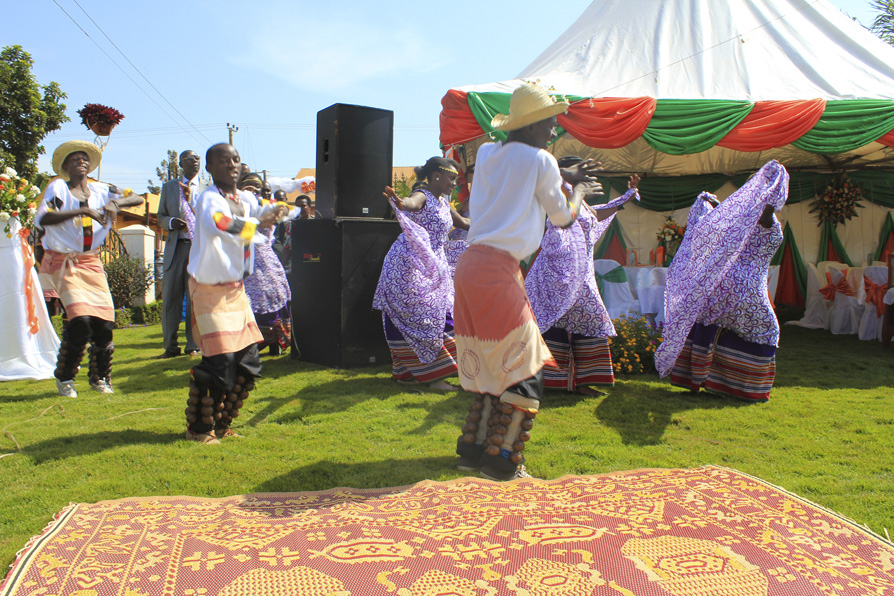 
Arrival of the wedding party
1. Onowuliranga Mukwaano - You will listen me, my dear bride, what I have to tell you
- wedding song of the Baganda people (Bantu)
- Sylvia Namulema Kigula - lead voice, backing voice
- Israel Kalungi - embuutu (big drum), backing voice
- Eric Lutaaya Jjemba - namunjoloba (small drum), empuunyi (bass drum), ensaasi (shakers), backing voice
- Ritah Kobusinge - namunjoloba (small drum), backing voice
The aunt explains to the bride what she has to do when she is married, this is to be wife and to keep the household in condition; to be mother and give birth to children and take care of their education and upbringing. The community is encouraged to support the newly wed girl to keep her marriage well.
2. Onkwatomugongo - Hold my back, give me support
- wedding song of the Banyankore people (Bantu)
- Ritah Kobusinge - lead voice, backing voice
- Sylvia Namulema Kigula - ensaasi (shakers), backing voice
- Israel Kalungi - embuutu (big drum), backing voice
- Eric Lutaaya Jjemba - namunjoloba (small drum), backing voice
The community is asked to support the bride in maintaining a good marriage.
3. Ngayaya - I want you
- wedding song of the Batooro people (Bantu)
- Ritah Kobusinge - lead voice
- Sylvia Namulema Kigula - backing voice
- Israel Kalungi - endingidi (tube fiddle), embuutu (big drum), backing voice
- Eric Lutaaya Jjemba - namunjoloba (small drum), backing voice
Ballad of love. The Basongora girl tells about her boy’s beauty and his handsome character and that it is a good choice to marry him. – /Ngayaya, ngayaya muhuma wange/ ..... are the words of the chorus which mean: "My lord, let us pray".
The Basongora people speak the Runyoro-Rutooro, a Bantu dialect similar to that of the poeple in the Kasese district in central western Uganda, to the boarder to Kongo. They are pastoralists, who have always moved south until today in search of the best pasture for their cattle.
7. Yamulesire Omwana - She has brought a beautiful girl
- wedding song of the Banyoro people (Bantu)
- Ritah Kobusinge - lead voice
- Sylvia Namulema Kigula - backing voice
- Israel Kalungi - embuutu (big drum), backing voice
- Eric Lutaaya Jjemba - empuunyi (bass drum), backing voice
The song praises the bride’s beauty who has been brought from the aunt into the house.
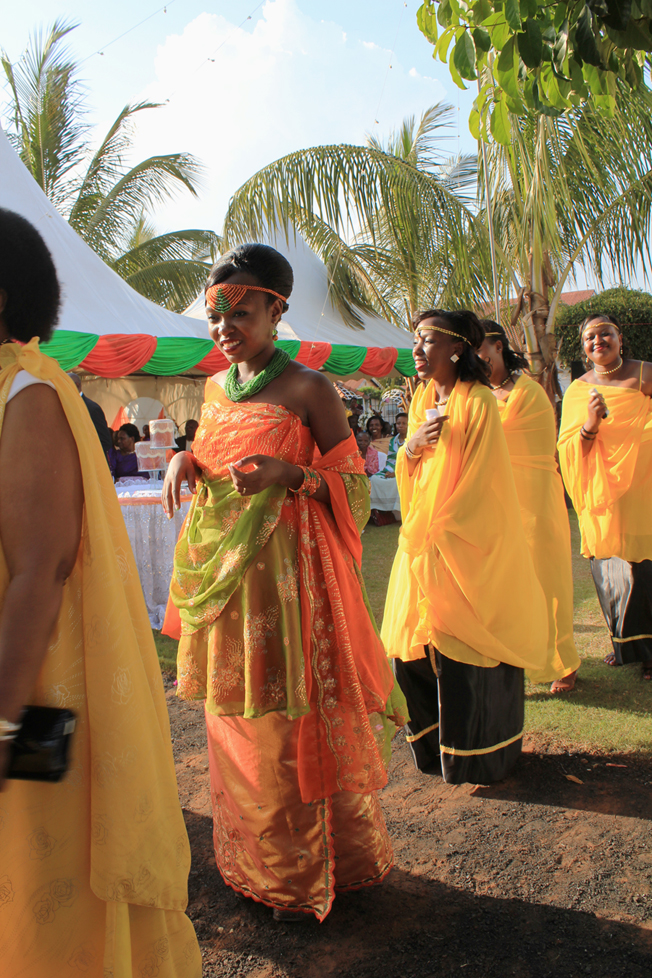 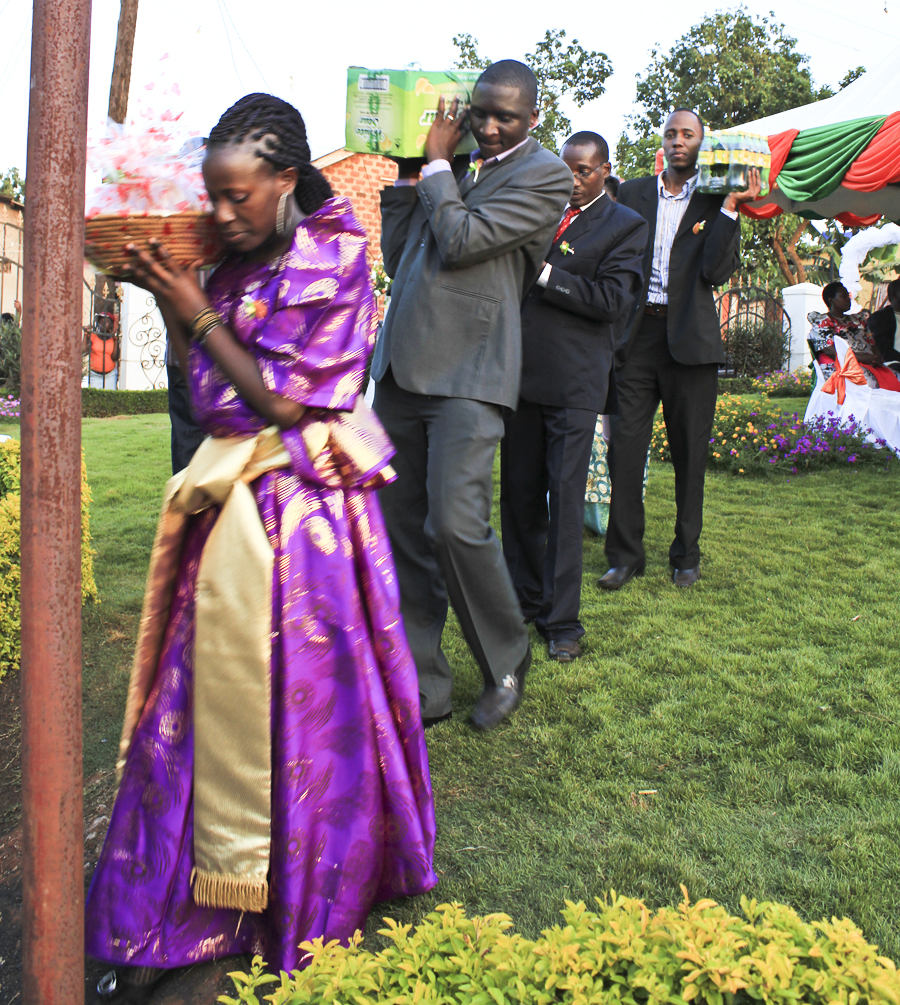
Arravial of the bride - Wedding presents are pressented

Wedding presents of the groom and his family
8. Nkararayo - I slept by there
- wedding song of the Banyoro people (Bantu)
- Ritah Kobusinge - lead voice, engalabi (long drum)
- Sylvia Namulema Kigula - backing voice
- Eric Lutaaya Jjemba - ebinyege (rattles), backing voice
- Israel Kalungi - empuunyi (bass drum), backing voice
The boy praises his bride, he has tested her.
- Gathering songs

catering
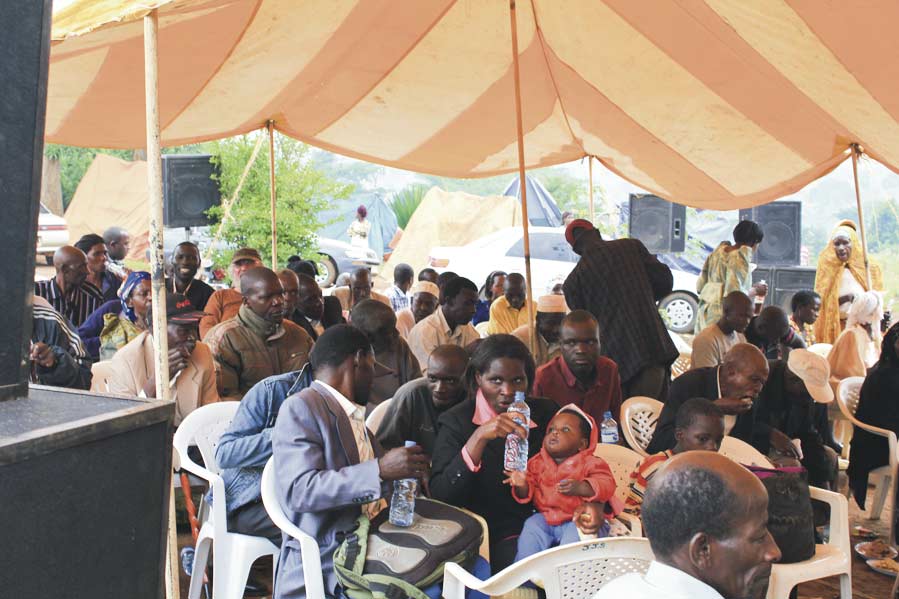 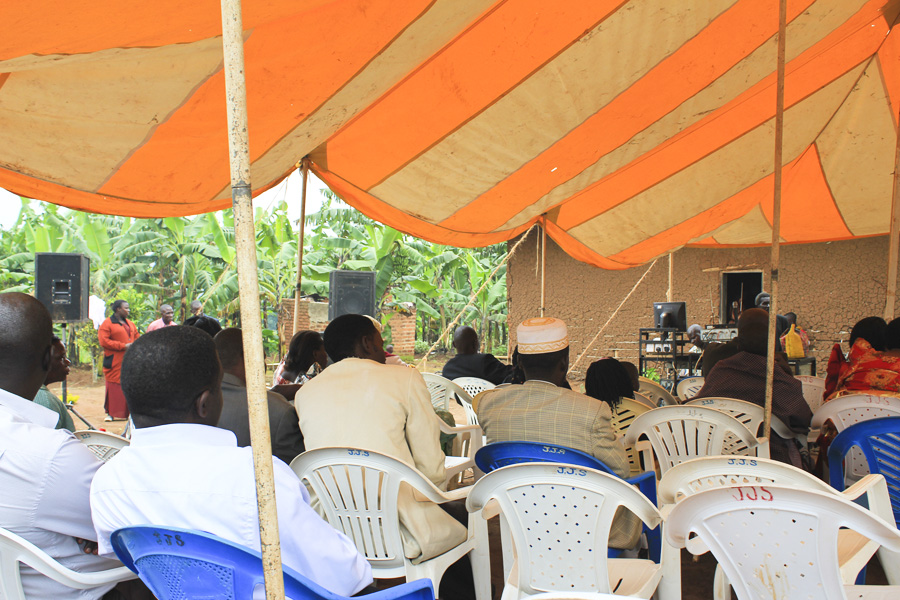
Clan gathering
4. Naleyo - Courtship dance of the Karimojong people (Hamites)
- Eric Lutaaya Jjemba - lead voice, backing voice
- Sylvia Namulema Kigula - backing voice
- Israel Kalungi - embuutu (big drum), endege (ankle bells), backing voice
- Ritah Kobusinge - namunjoloba (small drum), enkwanzi (panpipe), backing voice
5. Agwera Foneni - Welcome, happy to see you - Jopadhola (Luo) people (Hamites)
- Sylvia Namulema Kigula - lead voice, backing voice, endege (ankle bells)
- Israel Kalungi - adungu (bow harp), embuutu (big drum), backing voice
- Eric Lutaaya Jjemba - namunjoloba (small drum), backing voice
- Ritah Kobusinge - engalabi (long drum), backing voice
Welcome, feel at home and enjoy yourself. This song will be celebrated to start event, open ceremonies, gatherings etc.
6. Abavubi - Fishermen - Baganda people (Bantu)
- Israel Kalungi - lead voice, backing voice, embuutu (big drum), engalabi (long drum)
- Sylvia Namulema Kigula - backing voice
- Ritah Kobusinge - namunjoloba (small drum), backing voice
- Eric Lutaaya Jjemba - empuunyi (bass drum), backing voice
The songs talk about the hard work of the fishermen. Every early morning they go onto the lake and hope to bring home enough fish to feed their families and to sell their catch in order to support their families.
9. Owaro - Welcome - gathering song of the Samia people (Hamites)
- Sylvia Namulema Kigula - lead voice, backing voice
- Israel Kalungi - embuutu (big drum), backing voice
- Eric Lutaaya Jjemba - ensaasi (shakers), backing voice
- Ritah Kobusinge - ensaasi (shakers), backing voice
Welcome song in which the Samia people praise their happiness and the happy life they share. This song will be celebrated to start event, open ceremonies, gatherings etc.
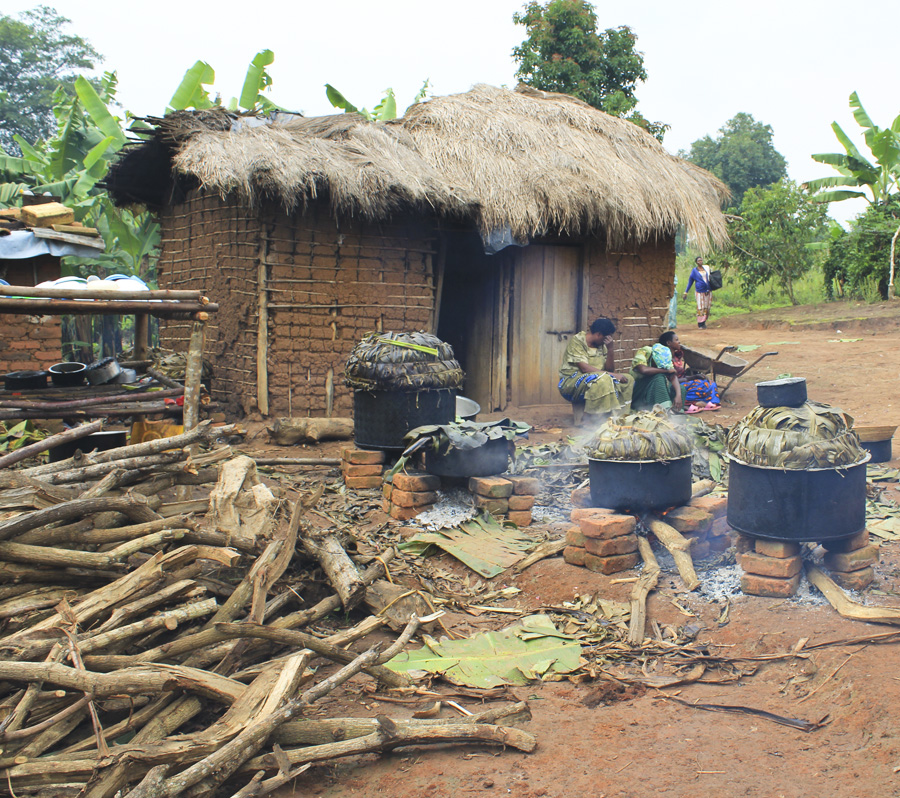 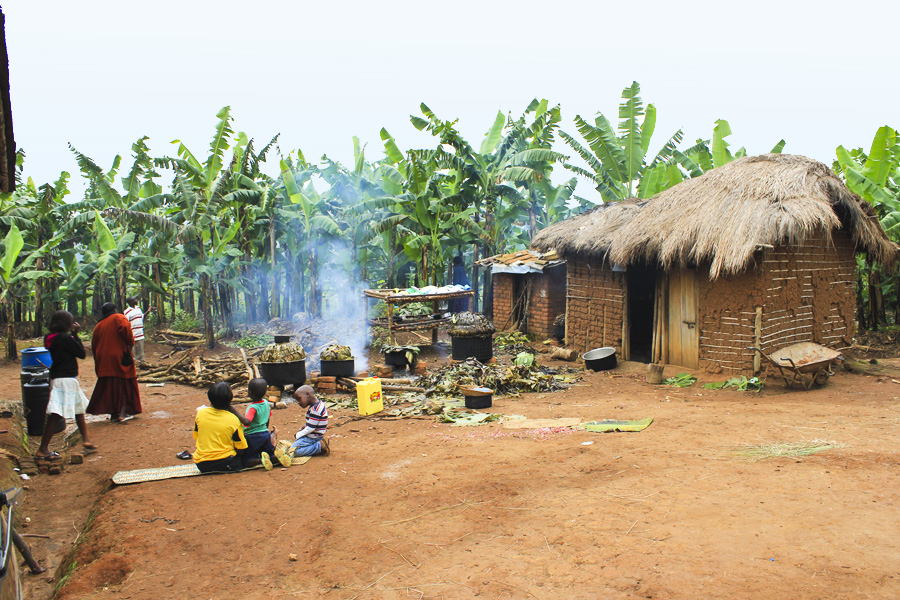
Open-air kitchen – clan gathering
10. Gaze - Dance from the people from the Western Nile (Hamites)
- Sylvia Namulema Kigula - lead voice, backing voice
- Israel Kalungi - embuutu (big drum), backing voice
- Ritah Kobusinge - namunjoloba (small drum), backing voice
- Eric Lutaaya Jjemba - backing voice
This is a children’s dance. It tells of their everyday life. They are still young and thus flexible. They are active and burst of energy.
Instruments
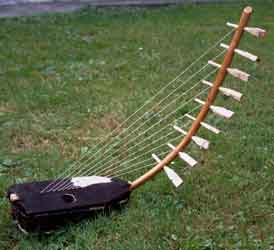 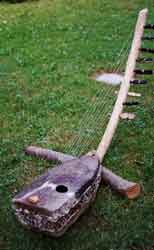 |
- Adungu - bow harp - arched harp - string instument
The adungu is a nine-string arched (bow) harp of the Alur people of northwestern Uganda. It is very similar to the tumi harp of the neighbouring Kebu people, and it is also used by the Lugbara and Ondrosi tribes in this northwestern region around the Nile. The harp is used to accompany epic and lyrical songs, and it is also used as a solo instrument or within ensembles. Players of arched harps have had a high social status and are included in royal retinues. Nowadays they also play in churches.
The adungu consists of an arched neck, a wooden resonator (sound box) in which the neck is fixed, and a series of parallel strings of unequal lengths that are plucked. The strings are fixed at one end to the resonator and run at an oblique angle to the neck, where they are attached and tuned with pegs.
|

|
- Endingidi - tube fiddle - one-string-fiddle - string instrument
This instrument is popular in the Buganda, Busoga, Ankole, Kigezi, western Nile, and Acholi regions. It consists of a single string, which is attached to a flexible stick and will sometimes have a resonator. Unlike other single-string instruments, it is played with a bow.
|
 |
- Enkwanzi - panpipe - wind instrument
The enkwanzi or oburere is a panpipe that comes from the Busoga region and is made from elephant grass or bamboo. They are stopped flutes, meaning that the node of the plant stops the hollow tube and thus determines the pitch of the pipe. The tubes are arranged from lowest to highest and laced together with string. The open rim at the top of each tube is cut at a right angle to the tube so that the player may blow across the top, like blowing across a bottle.
|
Drums in African tradition bring the power that drives a performance. Music is not merely entertainment, but it is ultimately bound to visual and dramatic arts as well as the larger fabric of life. Drums may be used for "talking"; that is, sending information and signals by imitating speech. Many African languages are both tonal (that is, meaning can depend on pitch inflections) and rhythmic (that is, accents may be durational), giving speech a musical quality that may be imitated by drums and other instruments. Drumming music and dance are almost always an accompaniment for any manner of ceremony; birth, marriages, funerals.
Engoma (Uganda drumset - percussion instrument) - While larger versions of this drum are traditionally hand-carved from old-growth hardwood trees, now these drums are made with pinewood slats tied together like barrels. Smaller drums are laminated and turned on a lathe and may be provided with a rope carrying the handle. All these drums have heads made from hide held by hardwood pegs hammered into the side of the drum.

|
- Namunjoloba
- small drum - percussion instrument
|
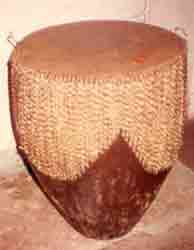
|
- Embuutu - big drum - percussion instrument
|

|
- Empuunyi
- bass drum - percussion instrument
|
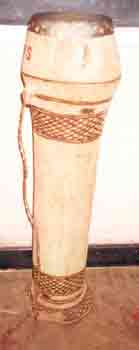 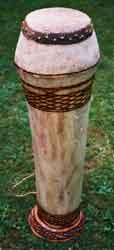
|
- Engalabi - long drum - percussion instrument
This traditional drum has a head made of reptile skin nailed to a wooden sound body.
The engalabi from the Buganda region has an important roles in ceremonies and in theater. It is called "okwabya olumbe". This is the installation of a successor to the deceased, thus the saying in Luganda (in Buganda a Bantu dialect) "tugenda mungalabi", meaning we are going to the engalabi, that is, long drumming.
Rule in playing the drum is the use of bare hands.
|

|
- Ensaasi - Enseege - shakers - percussion instrument
Shakers are made in pairs from gourds or shells, sometimes with stick handles, and are used to accompany other traditional instruments in Uganda. The central and northern (Alpaa) regions have shakers that produce a continuous sound as beads move from side to side in the gourd or shell. Generally, these shakers produce sounds by many small objects, such as pebbles, rattling together inside the body.
|


|
- Endege
- ankle bells - percussion instrument
Dancers frequently have metal jingles tied on their ankles to articulate their movements.
|
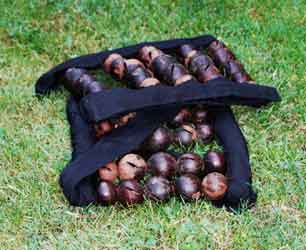
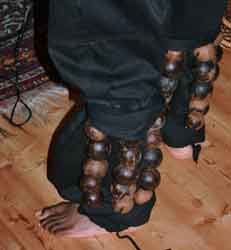
|
- Ebinyege - Binyege (Entongoro)
- rattles - percussion instrument
These originate in Bunyoro and Batooro (Toro) in Western Uganda along the roots of mountain Rwenzori. The seeds are put in these dry fruits to produce rhythmic patterns when shaken. Ebinyege are tied on the males legs to produce the sound and the Runyege dance (courtship dance of the Batooro) is named after the ebinyege, hence an important prop.
|
Revised by Hermelinde Steiner 2013
PageTop

|
